[FONT=Arial, Helvetica, sans-serif]How to install long tube headers on a 99 - 04 Mustang GT
[/FONT]
[/FONT]
[FONT=Arial, Helvetica, sans-serif]By Eric Jobe[/FONT]
[FONT=Arial, Helvetica, sans-serif]
 [/FONT] [FONT=Arial, Helvetica, sans-serif]
[/FONT] [FONT=Arial, Helvetica, sans-serif]
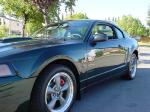 [/FONT] [FONT=Arial, Helvetica, sans-serif]
[/FONT] [FONT=Arial, Helvetica, sans-serif]
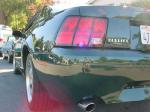 [/FONT]
[/FONT]
[FONT=Arial, Helvetica, sans-serif]BBK Long Tube Header Install on a 2001 GT[/FONT]
[FONT=Arial, Helvetica, sans-serif]Just Added - Before and After Dyno Results (.jpg, 74kb)
The results are in - increase of 20rwph and 15rwtq!![/FONT]
[FONT=Arial, Helvetica, sans-serif]Here are the steps I took to install BBK Long Tube Headers on my 2001 Mustang GT Bullitt. Following is the list of parts used, items needed for install, the steps involved, and a thorough description of each step. The nice part is the whole install can be done with common hand tools. Air tools could be used for a lot of the steps and they would make the job go faster, but I did the entire job with hand tools and little elbow grease.[/FONT]


[FONT=Arial, Helvetica, sans-serif]BBK Long Tube Header Install on a 2001 GT[/FONT]
[FONT=Arial, Helvetica, sans-serif]Just Added - Before and After Dyno Results (.jpg, 74kb)
The results are in - increase of 20rwph and 15rwtq!![/FONT]
[FONT=Arial, Helvetica, sans-serif]Parts:[/FONT]
- [FONT=Arial, Helvetica, sans-serif]BBK Long Tube Headers
[/FONT] - [FONT=Arial, Helvetica, sans-serif]BBK Shorty H-pipe
[/FONT] - [FONT=Arial, Helvetica, sans-serif]Bassani Gaskets
[/FONT] - [FONT=Arial, Helvetica, sans-serif]O2 wiring harness extender
[/FONT] - [FONT=Arial, Helvetica, sans-serif]Hi-temp RTV Gasket sealer
[/FONT] - [FONT=Arial, Helvetica, sans-serif]Hi-temp thread locker[/FONT]
- [FONT=Arial, Helvetica, sans-serif]Jack Stands (at least 2) and ramps. You could use 4 jack stands
[/FONT] - [FONT=Arial, Helvetica, sans-serif]Floor Jack. (2 is preferable, but could be done with 1)
[/FONT] - [FONT=Arial, Helvetica, sans-serif]Lug nut wrench and key for wheel locks
[/FONT] - [FONT=Arial, Helvetica, sans-serif]2X4 or 2X6 about 12" long
[/FONT] - [FONT=Arial, Helvetica, sans-serif]Socket Wrenches (ratchet) (1/4", 3/8" ½")
[/FONT] - [FONT=Arial, Helvetica, sans-serif]Sockets sized 8mm, 13mm, 15mm, 21mm, 24mm ( ¼", 3/8", ½")
[/FONT] - [FONT=Arial, Helvetica, sans-serif]Deep Sockets sized 13mm, 15mm, 18mm (3/8". ½")
[/FONT] - [FONT=Arial, Helvetica, sans-serif]Socket Extensions 3", 6", 12" (1/4", 3/8", 1/2")[/FONT]
- [FONT=Arial, Helvetica, sans-serif]Open-end wrenches sized 10mm, 13mm, 15mm, 18mm
[/FONT] - [FONT=Arial, Helvetica, sans-serif]Open-end stubby wrench 13mm[/FONT]
- [FONT=Arial, Helvetica, sans-serif]Torx bit sized E8 (1/4")
[/FONT] - [FONT=Arial, Helvetica, sans-serif]Large crescent wrench
[/FONT] - [FONT=Arial, Helvetica, sans-serif]Breaker Bar (½")[/FONT]
- [FONT=Arial, Helvetica, sans-serif]Long screwdriver or prybar
[/FONT] - [FONT=Arial, Helvetica, sans-serif]Hammer
[/FONT] - [FONT=Arial, Helvetica, sans-serif]Pliers
[/FONT] - [FONT=Arial, Helvetica, sans-serif]Wire cutters (Dikes)
[/FONT] - [FONT=Arial, Helvetica, sans-serif]Dremel tool
[/FONT] - [FONT=Arial, Helvetica, sans-serif]Zip-ties
[/FONT] - [FONT=Arial, Helvetica, sans-serif]Coat hangers
[/FONT] - [FONT=Arial, Helvetica, sans-serif]Can or box for loose parts[/FONT]
- [FONT=Arial, Helvetica, sans-serif]Jack car up and support on stands/ramps (loosen lug nuts on front rims first)
[/FONT] - [FONT=Arial, Helvetica, sans-serif]Remove front rims
[/FONT] - [FONT=Arial, Helvetica, sans-serif]Disconnect the battery
[/FONT] - [FONT=Arial, Helvetica, sans-serif]Remove rotors
[/FONT] - [FONT=Arial, Helvetica, sans-serif]Remove tie-rods from spindles
[/FONT] - [FONT=Arial, Helvetica, sans-serif]Remove sway bar end links
[/FONT] - [FONT=Arial, Helvetica, sans-serif]Remove struts from spindles
[/FONT] - [FONT=Arial, Helvetica, sans-serif]Remove ABS sensor from spindle
[/FONT] - [FONT=Arial, Helvetica, sans-serif]Remove Springs
[/FONT] - [FONT=Arial, Helvetica, sans-serif]Remove steering shaft
[/FONT] - [FONT=Arial, Helvetica, sans-serif]Remove steering rack
[/FONT] - [FONT=Arial, Helvetica, sans-serif]Remove rear g-load brace from K-member
[/FONT] - [FONT=Arial, Helvetica, sans-serif]Support the engine
[/FONT] - [FONT=Arial, Helvetica, sans-serif]Remove motor mount nuts
[/FONT] - [FONT=Arial, Helvetica, sans-serif]Remove K-member
[/FONT] - [FONT=Arial, Helvetica, sans-serif]Remove motor mounts
[/FONT] - [FONT=Arial, Helvetica, sans-serif]Remove X-pipe/H-pipe portion of exhaust system
[/FONT] - [FONT=Arial, Helvetica, sans-serif]Remove exhaust manifolds
[/FONT] - [FONT=Arial, Helvetica, sans-serif]Remove oil dipstick tube on driver's side
[/FONT] - [FONT=Arial, Helvetica, sans-serif]Install new gaskets[/FONT]
- [FONT=Arial, Helvetica, sans-serif]Install headers
[/FONT] - [FONT=Arial, Helvetica, sans-serif]Install oil dipstick tube
[/FONT] - [FONT=Arial, Helvetica, sans-serif]Install motor mounts
[/FONT] - [FONT=Arial, Helvetica, sans-serif]Connect O2 Harness extensions
[/FONT] - [FONT=Arial, Helvetica, sans-serif]Install K-member
[/FONT] - [FONT=Arial, Helvetica, sans-serif]Install motor mount bolts
[/FONT] - [FONT=Arial, Helvetica, sans-serif]Install steering rack
[/FONT] - [FONT=Arial, Helvetica, sans-serif]Reattach steering shaft
[/FONT] - [FONT=Arial, Helvetica, sans-serif]Install G-load brace on K-member
[/FONT] - [FONT=Arial, Helvetica, sans-serif]Install Springs
[/FONT] - [FONT=Arial, Helvetica, sans-serif]Reattach ABS wiring harnesses
[/FONT] - [FONT=Arial, Helvetica, sans-serif]Reattach Struts to spindles
[/FONT] - [FONT=Arial, Helvetica, sans-serif]Reattach sway bar end links
[/FONT] - [FONT=Arial, Helvetica, sans-serif]Reattach tie-rod ends
[/FONT] - [FONT=Arial, Helvetica, sans-serif]Attach Calipers
[/FONT] - [FONT=Arial, Helvetica, sans-serif]Install new H-pipe to headers and cat-back
[/FONT] - [FONT=Arial, Helvetica, sans-serif]Attach rear O2 harness
[/FONT] - [FONT=Arial, Helvetica, sans-serif]Reconnect battery
[/FONT] - [FONT=Arial, Helvetica, sans-serif]Lower the car
[/FONT] - [FONT=Arial, Helvetica, sans-serif]Go for a test drive[/FONT]
[/FONT]
[FONT=Arial, Helvetica, sans-serif](Click thumbnails for full-sized image)[/FONT]
- [FONT=Arial, Helvetica, sans-serif] Support the car on some combination of jack stands and ramps. I chose to use ramps to support the rear of the car because I prefer not to have the car on 4 jackstands. Loosen the lug nuts on the front rims before raising the car to facilitate removing the rims once the car is jacked.
[/FONT] - [FONT=Arial, Helvetica, sans-serif]Remove the front rims from the vehicle using a 13/16" deep socket or lug wrench that came with the vehicle.
[/FONT] - [FONT=Arial, Helvetica, sans-serif]Disconnect the negative terminal from the battery using an 8mm socket or box-end wrench.[/FONT]
- [FONT=Arial, Helvetica, sans-serif] Remove the brake calipers from the spindles on both sides of the vehicle using a 15mm socket and a breaker bar to get the 2 bolts loose. Then use a standard socket wrench to finish removing the bolts. The calipers need to be hung out of the way using a coat hanger or a strong piece of wire. Use a coat hanger, doubled up, to support the caliper by running the wire through a hole in the strut tower and twisting the hanger around the top of the strut mount.[/FONT]
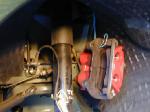
Brake Caliper Removed[/FONT]
- [FONT=Arial, Helvetica, sans-serif]Remove the rotors from both sides of the vehicle. There are 2 retaining clips on the rotor hat that have to be removed to get the rotor off. They can be spun off or simply cut with a pair of dikes. (They do not need to be reinstalled) I didn't remove the rotors to do the following 5 steps on the drivers side, but later I removed them for weight reasons and it makes the following steps easier. This is why the pictures show the rotors in place when the springs are already removed.
[/FONT] - [FONT=Arial, Helvetica, sans-serif]Remove the tie-rod ends from the spindles on both sides of the vehicle. First remove the cotter-pin holding the nut in place, then use an 18mm deep socket to remove the nut. Hammer on the top of the bolt after the nut is removed to drop the end joint out of the spindle. It helps to turn the wheel outward to gain access to the end joints.
[/FONT] - [FONT=Arial, Helvetica, sans-serif]Remove sway bar end links on both sides of the vehicle using a 15mm deep socket on the nut and a 10mm open-end wrench on the link to prevent it from twisting. There is a flat spot in the middle of the link where the 10mm open-end wrench fits[/FONT]
- [FONT=Arial, Helvetica, sans-serif] Remove struts from spindles by placing a jack under the control arm to jack up the control arm to compress the spring. First, remove the bracket that holds the ABS sensor harness in place using a 24mm socket. Move the bracket out of the way. Then, using a 24mm socket and breaker bar on the nut and a 21mm socket on the bolt loosen the 2 bolts. Finish removing the 2 strut bolts holding the strut to the spindle with a socket wrench. Swing the strut out of the way. Hold the spindle in place until the ABS sensor can be removed to prevent damaging the sensor. (The procedure is the same for both driver and passenger sides.)[/FONT]

- [FONT=Arial, Helvetica, sans-serif]Remove ABS sensor from spindle using E8 Torx-bit and hang out of the way. [/FONT]
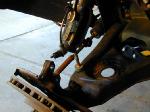
- [FONT=Arial, Helvetica, sans-serif] Remove the coil spring. Make a mark on the lower spring perch where the last coil ends. This allows the spring to be reinstalled in the same location. Slowly lower the jack under the control arm to allow the spring to expand. Allow the spring to expand to it's fully uncompressed length. The spring will still be wedged in the spring perch. Push down on the lower control arm and extract the spring from it's perch. Be very careful doing this!! Make sure all of the pressure is off of the spring before pushing down on the control arm. . (The procedure is the same for both driver and passenger sides.)[/FONT]

- [FONT=Arial, Helvetica, sans-serif]Remove the steering shaft nut from the bottom of the shaft where it connects to the steering box using a long extension and 13mm socket. Turning the steering wheel helps to expose the bolt. The bolt is accessed through a cutout in the K-member right behind the spring on the driver's side or from underneath the car. Pull the shaft off of the steering box. The shaft is comprised of an inner and outer sleeve. The inner sleeve can be retracted into the outer sleeve when you pull it off of the steering box.
[/FONT] - [FONT=Arial, Helvetica, sans-serif] Remove the steering rack from the front of the K-member using a 15mm socket on the 2 front bolts and an 18mm deep socket and extension on the 2 nuts on rear. Remove the long bolt assemblies. Pry the steering rack off of the K-member. This may take some force as the rubber bushings seem to sort of glue themselves to the K-member. Once the steering rack is pried away hang it from the sway bar using a coat hanger or zip-ties. [/FONT]
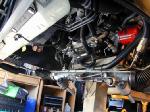
- [FONT=Arial, Helvetica, sans-serif] Remove the 2 bolts from the G-load brace on the rear of the K-member using a 15mm socket. This gives the access needed to place a jack under the vehicle and support the engine from the oil pan.
[/FONT] - [FONT=Arial, Helvetica, sans-serif]Support the motor. Using a floor jack with a 2X6 about 12" long on top of it, get under the vehicle and jack the board up directly under the oil pan until it is firmly against the pan. Use the floor jack with the handle pointing to the rear of the vehicle to make it easier to remove the K-member out the front of the car. [/FONT]
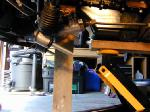
- [FONT=Arial, Helvetica, sans-serif]Remove the nut attaching the motor mount to the K-member using an 18mm socket and breaker bar with extensions to loosen the nut and finish with a socket wrench. The nut is located behind the spring in the K-member on each side of the vehicle.
[/FONT] - [FONT=Arial, Helvetica, sans-serif]Remove the K-member. Support the K-member with a second jack or jack stands. Use a breaker bar with 18mm and 15mm sockets to loosen the 8 bolts that hold the K-member in place. Finish removing the bolts with a socket wrench. There are 2 bolts in the upper spring perch area on both sides of the vehicle. There are 2 bolts on each side underneath the vehicle in the rear portion of the K-member. Once all 8 of the bolts are removed, slowly lower the K-member away from the vehicle making sure it is not getting hung up on anything. After the K-member is dropped away get some help and move it aside and out of the way. This is a two person job. The K-member is heavy and awkward. After removing the K-member I added an additional support under the block for safety reasons. I added a 4X4 piece of wood with a 2X4 lying across the top of it under the front portion of the oil pan that was exposed after the removal of the K-member. A second jack or jackstand could have been used for this purpose. [/FONT]
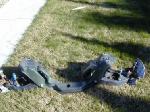
[FONT=Arial, Helvetica, sans-serif]

- [FONT=Arial, Helvetica, sans-serif]Remove the motor mounts from the engine block using 15mm and 13mm deep sockets. The driver side motor mount has two ground straps attached to it with 15mm nuts. These need to be removed to access the 13mm nuts that hold the motor mount to the block. Each motor mount is held in place by 3 nuts. The passenger side has a bracket that holds the starter cables and it needs to be removed before the motor mount nuts can be accessed. [/FONT]
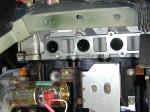
- [FONT=Arial, Helvetica, sans-serif]Remove H-pipe/X-pipe section of the exhaust using a combination of 13mm and 15mm deep sockets and 15mm box-end wrench. Remove the 2 nuts from the exhaust manifold studs on each side. Then remove the 4 nuts and bolts from the rear portion where it connects to the cat-back. Pull and wiggle the exhaust at the tail section until it comes free from the cat-back and then slide it off of the exhaust manifold studs. At this point swap the O2 sensors from the existing H/ X-pipe to the new shorty H/X-pipe. The rears are color coded so make sure they go into the correct side on the new pipe. Put a light coating of anti-seize on the 02 sensor threads before installing in the new H/X-pipe.[/FONT]
- [FONT=Arial, Helvetica, sans-serif]Remove exhaust manifolds using a 13mm deep socket and extensions. It is a straight shot to all 8 of the nuts holding the exhaust manifolds in place. Some of the studs may come out with the nuts, but they can be threaded right back in and be reused. The driver side manifold has the EGR fitting on the rear of the manifold that requires a large open-ended wrench or a large crescent wrench. Remove the nut from the EGR fitting and move the EGR tube out of the way. The exhaust manifolds slide right off of the studs after the nuts are removed. Remove the exhaust manifold gaskets if it they are not going to be reused. [/FONT]
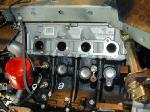
- [FONT=Arial, Helvetica, sans-serif]Remove the oil dipstick tube using an 8mm socket. The oil dipstick tube on the drivers side of the vehicle needs to be removed before the new header can be installed. Pull the dipstick out of the tube and remove the nut holding the tube in place. Pull up on the tube and it comes out of the block. The tube goes into the block about 1 ½-2". I found it was easier to remove the tube from the block and then pull it out from underneath the vehicle.
[/FONT] - [FONT=Arial, Helvetica, sans-serif]Install new gaskets onto studs. I chose to use Bassani header gaskets when doing the install. They are very high quality copper and graphite gaskets that should prevent any exhaust leak from ever occurring. I looked at the stock gaskets and think these would be a better choice than the gaskets supplied by BBK if price is a consideration. The Bassani gaskets were less than $50 and are well worth the money if it means not having to try to replace gaskets down the road.[/FONT]
- [FONT=Arial, Helvetica, sans-serif]Install headers. A little note: it is a good idea to stuff a rag between the header pipes down by the collector before installing to prevent dropped nuts/bolts from getting wedged down by the collector. (it happened to me twice) Slide the header flange over the studs and gasket. Reattach the EGR tube on the driver's side. This helps hold the header in place while the other bolts are being threaded on. Finger-tighten a few nuts while supporting the header to prevent it from falling back off. On the driver's side the header tubes interfere with the two bottom rear studs. This requires the second stud in from the rear to be shaved down. Using a Dremel tool to cut off the portion of the stud without threads gives the necessary clearance. The rear stud can not be used at all. Use an 8mmX25mmX1.25 thread count bolt in the lower rear position. The BBK supplied 8mmX20mmX1.25 thread count bolt was to short when used with a lock washer, and Bassani gasket, which was thicker than stock gasket. Most of the nuts on the driver side header were easily accessible and could be tightened with a 13mm deep socket and long extensions. I used a 13mm open-end wrench to get to a couple of the top nuts. There was room to move the wrench through about a ¼- 1/2 of a turn. It was tedious but all nuts could be tightened fairly easily. Snug all the nuts down tight enough to squish the gasket and feel tight. Don't try to tighten them as much as possible because it might strip the studs out of the block. I sort of did it by feel. The passenger side header required a little more finesse to get in. Loosen the mounting bolts on the A/C compressor a few turns to allow it to move out of the way enough to get the header flange to slide onto the studs. Lower the motor about 3 inches to allow access to the top two rear nuts on the passenger side. There is very little clearance between the header and frame rail on the passenger side. Tighten the top two rear nuts with a 13mm open-end wrench and a lot of patience. Using a 13mm stubby open-end wrench makes this easier. I used a standard 13mm open-end and could only turn the nut about an 1/8th of a turn each time because of interference from the valve cover. Make sure all nuts are tightened firmly enough to squish gasket and feel snug.[/FONT]

- [FONT=Arial, Helvetica, sans-serif] Install the oil dipstick tube by sliding it down from the top of the engine in between the 2nd and 3rd pipe from the left on the header. The tube will have to be bent slightly in order for it to clear the header flange. Remove the fuse box cover in the engine compartment to give the added clearance needed when sliding the tube back in place. Reinstall the retaining nut with an 8mm socket. Reinstall dipstick into tube.
[/FONT] - [FONT=Arial, Helvetica, sans-serif]Install the motor mounts using 15 mm and 13mm deep sockets and extensions. Make sure the ground straps and wring harness brackets get reinstalled on their respective sides. Tighten down the nuts using the breaker bar for leverage.
[/FONT] - [FONT=Arial, Helvetica, sans-serif]Connect the O2 sensor wiring harness extension to the connector on the rear of the block and O2 sensor at the header collector for each side. Zip-tie the wires away from the headers.[/FONT]

- [FONT=Arial, Helvetica, sans-serif] Install the K-member. Jack the engine back to its normal height or a little above. While still supporting the engine with the floor jack remove the extra support from the oil pan. Use a floor jack to raise the K-member back into the original position under the vehicle. Using 15mm and 18mm sockets reinstall the 8 bolts that hold the K-member in place. Use a breaker bar for extra leverage to tighten the bolts.[/FONT]
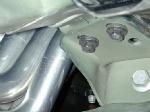
- [FONT=Arial, Helvetica, sans-serif]Install the motor mount bolts. Lower the engine down into position making sure the motor mounts line up properly. Using an 18mm socket and extension install the bolt that attaches the motor mount to the K-member. Finish by tightening with the breaker bar.
[/FONT] - [FONT=Arial, Helvetica, sans-serif]Install steering rack. Cut the zip-ties holding the steering rack to the sway bar. Using 15mm socket and 18mm deep socket with extension reinstall the steering rack onto the K-member. Finish by tightening the bolts with the breaker bar.
[/FONT] - [FONT=Arial, Helvetica, sans-serif]Reattach steering shaft. Slide the steering shaft over the fitting on the steering box and use a 13mm socket to tighten the retaining bolt.
[/FONT] - [FONT=Arial, Helvetica, sans-serif]Install G-load brace using 15mm socket. Torque bolts down with breaker bar.[/FONT]
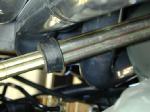
- [FONT=Arial, Helvetica, sans-serif] Install springs. Install the spring back into their perch by pushing down on the lower control arm and swinging them in top first. Make sure the springs are aligned with the pigtail in the same location it was prior to removing. Using a floor jack under the control arm, jack the control arm up to compress the spring. Procedure is the same for both sides[/FONT]

- [FONT=Arial, Helvetica, sans-serif]Reattach ABS sensor to spindle using E8 Torx-bit and a dab of hi-temp thread locker.
[/FONT] - [FONT=Arial, Helvetica, sans-serif]Reattach struts to spindles using 21mm and 24mm sockets. Use a dab of hi-temp thread locker on the threads of the bolt and torque down with breaker bar. Reattach the ABS wiring harness bracket to the strut using a 24mm socket.
[/FONT] - [FONT=Arial, Helvetica, sans-serif]Reattach sway bar end links using a 15mm deep socket and 10mm open-end wrench on the flat spot in the middle of the end link to keep the link from twisting. Tighten the nut until the bushings are slightly squished. [/FONT]

- [FONT=Arial, Helvetica, sans-serif]Reattach tie-rods to the spindle. Using an 18mm deep socket tighten the nut on the end joint. Tighten the nut until the end joint is pressure fit into the spindle back the nut off a quarter of a turn then snug it back up. Line up one of the slots in the nut with the hole that passes through the end joint and install the cotter-pin.[/FONT]

- [FONT=Arial, Helvetica, sans-serif]Attach rotors and calipers to spindle. . Slide the rotor onto the studs and then slide caliper over rotor and attach using 15mm socket. Put a dab of hi-temp thread locker on the bolts before installing on spindle. Torque the bolts up with the breaker bar to make sure they are tight.
[/FONT] - [FONT=Arial, Helvetica, sans-serif]Put rims back on using lug wrench or 13/16" deep socket and torque lug nuts down to 100 ft/lb.
[/FONT] - [FONT=Arial, Helvetica, sans-serif]Install the shorty H/X-pipe to the headers and cat-back using a combination of an 18mm deep socket, 15mm deep socket and, 15mm box-end wrench. Put a bead of hi-temp RTV gasket maker on the h/x-pipe where it fits over the header flange to make sure this area seals up tightly. Fit the pipe up and loosely install the nuts on the studs at the header collector. Lift the rear of the pipe into position and install the bolts into the cat-back portion of the exhaust. Working back-and-forth, tighten up the nuts and bolts at each connection point until the ball fitting fits snuggly inside of the exhaust pipe. Doing this may require help from an assistant to push or pull on the h/x-pipe assembly so that it mates up with header flange. In my case the h-pipe need to be spread about an inch for it to mate up to the collector on the header properly.
[/FONT] - [FONT=Arial, Helvetica, sans-serif]Attach rear O2 sensors to their respective connector on the tail of the transmission housing.
[/FONT]
- [FONT=Arial, Helvetica, sans-serif]Reconnect negative terminal on battery using 8mm socket or box-end wrench.
[/FONT] - [FONT=Arial, Helvetica, sans-serif]Close the hood and lower the car down off of the jack stands and ramps.
[/FONT] - [FONT=Arial, Helvetica, sans-serif]Take the car for a test drive. Listen for exhaust leaks and rattles. Make sure the car drives straight and feels right. It may be necessary to take the car to get it aligned if the suspension was not installed in the exact same location. If it pulls to one side or the steering wheel is no longer straight I would recommend having and alignment shop do an alignment.[/FONT]
[FONT=Arial, Helvetica, sans-serif]Below is a short mpeg of the exhaust. [/FONT]
[FONT=Arial, Helvetica, sans-serif]

.mpg, 796kb[/FONT]

.mpg, 796kb[/FONT]

